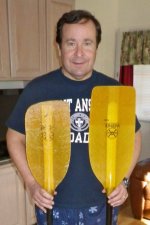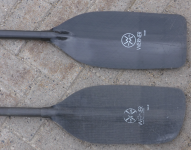- Joined
- Nov 22, 2021
- Messages
- 221
- Reaction score
- 93
Last year (2023) I bought a Werner Bandit. A whitewater paddle with carbon shaft and curved fiberglass blade.
I don't do serious whitewater, but I thought it might come in handy.
I used it once, didn't like it and never used it again.
Last trip of the year, one of the other guys paddling stern in a tandem, was using one. I told him I had one but couldn't get the hang of it.
Since then I've been noticing that an awful lot of people, in my club, are using the Aqua Bound Edge, which has nearly identical specs, and moving along very well.
Mostly in solo canoes, but also the stern of some tandems.
The way they all seem to be using it is, at the end of the power stroke, they do a little rudder. Not sure, at this point, if the thumb of the top hand is pointing up or down, but I think it's mostly up. No one is doing a proper J-stroke.
I'm talking about very experienced paddlers and even an ACA instructor.
So, I'm taking another look at my Bandit. Maybe I was a little too hasty to set it aside.
I don't do serious whitewater, but I thought it might come in handy.
I used it once, didn't like it and never used it again.
Last trip of the year, one of the other guys paddling stern in a tandem, was using one. I told him I had one but couldn't get the hang of it.
Since then I've been noticing that an awful lot of people, in my club, are using the Aqua Bound Edge, which has nearly identical specs, and moving along very well.
Mostly in solo canoes, but also the stern of some tandems.
The way they all seem to be using it is, at the end of the power stroke, they do a little rudder. Not sure, at this point, if the thumb of the top hand is pointing up or down, but I think it's mostly up. No one is doing a proper J-stroke.
I'm talking about very experienced paddlers and even an ACA instructor.
So, I'm taking another look at my Bandit. Maybe I was a little too hasty to set it aside.


